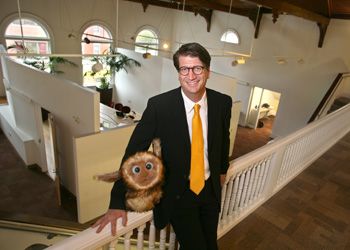Promoted | Maine marketing firms capitalize as national clients seek a personal touch and affordable rates
 Photo/Tim Greenway
The "bundle," FairPoint's mascot for its TV, Internet and phone package, snuggles up to John Coleman, VIA Group CEO
Photo/Tim Greenway
The "bundle," FairPoint's mascot for its TV, Internet and phone package, snuggles up to John Coleman, VIA Group CEO
John Coleman is heading up an independent ad agency that’s competing in a cutthroat global marketplace from the remotes of Maine at a time when grabbing consumers’ attention is perhaps more difficult than ever. But he’s not above taking a few minutes from his day to revel at the sight of a furry little puppet.
Sitting in his Portland office, the founder and CEO of The VIA Group is reduced to giddiness as one of his employees, Teddy Stoecklein, crouches behind a leather loveseat to manipulate the wide-eyed puppet to full effect, perking up its rabbit-like ears independently and then, adorably, in unison. Coleman has seen this all before — the puppet is part of a now widely recognized ad campaign VIA created for FairPoint Communications — but its effect on him remains undiminished.
Its effect on consumers appears equally as strong. The puppet, constructed by Muppet master Jim Henson’s Creature Shop, is the centerpiece of FairPoint’s marketing push to promote its bundle of high-speed Internet, phone and DIRECTV services. “Love your bundle,” the ads prompt in a series of TV spots that show the puppet fishing, coughing up a dollar bill and even attempting the notoriously difficult iron cross gymnastics move with trembling determination. (A stunt bundle handles tougher assignments, like getting wet). Designed to convey the bundle’s “fast, reliable service,” the campaign also has the bundle tweeting and inspiring fans to request dolls in its likeness. “Unbelievable,” Coleman, incredulous, says of the response to the ads. “Unbelievable. It has so exceeded my expectations. People love the bundle.”
The FairPoint contract, which VIA shares with another Portland firm, Garrand, is the latest in a trend by national companies to hire local, independent firms to handle their marketing campaigns. The shift began years ago as technology began to level the playing field between smaller firms and their big-city counterparts, but has taken on new urgency with the economic downturn, according to Tony Mikes, founder of Second Wind, a Pennsylvania trade association that represents 800 small- to mid-sized agencies. “There is a significant trend toward downsizing for larger clients, clients that normally, in better times, would have gone to larger agencies,” he says.
Among the other big-name brands Maine agencies have landed are auto dealer Faulkner-Ciocca Automotive of Philadelphia; Con-Way, a multi-billion-dollar transportation company in Michigan; and RBC Bank, based in North Carolina.
FairPoint checked out a dozen ad firms in Maine, New Hampshire and Vermont before awarding the contract to the two Portland firms, work that formerly went to the storied Hill Holliday in Boston. “We really like Garrand and VIA a lot, and they both had unique strengths that together made a better solution to our marketing and advertising needs,” says Jim Weigert, VP of marketing for FairPoint. The fact that both firms are also FairPoint customers who understand the product and its competitors in the market was a big plus, he says.
Today, clients managing tighter budgets want great ideas, rather than “butts in a seat,” Mikes says. “A small and smart agency can take big clients and can service them and can do the job only a very large agency could do in the past.”
Heeding the call
Most of the world’s large and mid-sized advertising agencies are owned by a handful of conglomerates. Omnicon and Interpublic, both of New York, WPP of London and Publicis Groupe of Paris together account for tens of billions of dollars in revenues and about 160,000 employees.
Garrand, a Portland firm of 31 employees, has managed to shrink the ad giants’ ranks by two. Maine’s slower pace and ocean views lured both Senior VP Jon Hutter, previously an account planner with WPP’s Grey Group, and Executive Creative Director Larry Vine, formerly of Publicis Groupe’s Saatchi & Saatchi, away from high-powered careers in New York. Vine passed up an opportunity to run Johnson & Johnson’s creative work in Asia to move to Portland. “They come here because they want to live and work here,” says Brenda Garrand, the firm’s founder and CFO.
Mikes of Second Wind calls it “the Portland factor” — a combination of quality of life, outdoor recreation and a hip creative community that many metro areas just can’t offer. “You’ve got this cadre of advertising agency professionals that don’t want to be in New York or Chicago or Atlanta anymore,” he says. Garrand recently was named one of Advertising Age’s top 30 best places to work in media and marketing in the country, the only agency in New England to make the cut.
Big clients have picked up on the fact that they can spend less and still tap into top-notch talent at smaller firms. “When you deal with a small, regional firm like us, you tend to work with principals, with senior executives,” and enjoy a strong focus on customer service, Garrand says. “Our overhead is a lot less, even though we pay people well.” She likens firms such as hers to regional theatres, known for their nimbleness and fresh ideas, and larger agencies to the flashier but stodgier Broadway.
National contracts to market everything from business communications to sour cream make up about 60% of Garrand’s $12 million annual business, with the other 40% coming from local organizations. Among the firm’s largest clients are Osram Sylvania, the $2 billion lighting company, and the HP Hood family of brands. On the FairPoint contract, Garrand handles public relations, event work and the rollout of the North Carolina company’s VantagePoint business communication services. VIA, meanwhile, focuses on the consumer side, marketing FairPoint’s products for residents and small businesses. (Both firms spoke well of each other, but Mikes of Second Wind advocates a one-firm approach, saying “FairPoint is too small a client, as big as they are, to have two agencies running around, even as nicely as they play.”)
While it’s not either firm’s largest client — VIA’s is Welch’s grape juice — FairPoint presents a formidable marketing challenge. When it announced the two firms as winners of its contract in late 2009, the company had just filed for Chapter 11 bankruptcy protection after losing more than $100 million that year. Soon to follow were tussles with creditors, an order to rebate customers more than $8 million to compensate for poor service and just this August, the ouster of CEO David Hauser.
So the decision to cast a furry mascot as the face of the company’s products in light of such consumer angst was, to say the least, unorthodox. VP of Marketing Wiegert spent a week agonizing over whether to back VIA’s pitch to upper management. “This is either really going to work well or my boss isn’t going to be happy with me,” he recalls thinking. While declining to provide specifics, Weigert says the campaign has significantly boosted sales and helped to support major acquisition efforts.
FairPoint’s competing against Time Warner and Comcast, which each have the advantage of advertising for free on their own television networks. “It’s like going to a gunfight with a knife,” Coleman says. But the bundle puppet — sort of a cuddlier, less robotic version of another pop culture sensation, the Furby — has encouraged positive associations with the FairPoint brand, and helped to co-opt the word itself, according to Coleman. “We’ve taken the word out of the lexicon,” he says. “Consumers identify the bundle with FairPoint.”
The communications company is one of VIA’s 13 national clients, which also include Samsung, Discover Card and Unilever. The leveling effect of technology and the Internet has been both a blessing and a curse, allowing smaller agencies like VIA to compete for those big contracts, but also upending the way consumers access information, making it tougher to pinpoint how to best reach certain market segments, according to Coleman. “It’s a renaissance for advertising and marketing, but it’s not for the faint of heart. It’s all getting reinvented,” he says. “It’s not easy to target certain demographics and figure out the psychological characteristics of people.”
Coleman has managed to target top talent; 95% of his 70-person staff is from outside of Maine, thanks to the quality of life Maine offers. But Portland remains a small city by most standards with 70,000 residents, and not everyone can be convinced to give up Big Apple thrills for Forest City comforts, he says.
Still, VIA’s making a name for itself, coming in second in AdAge’s nationwide 2010 small agency of the year competition. Fresh off the grand opening celebration for its new offices in the historic Baxter Building on Congress Street, VIA is in the process of signing with two more national brands. “[Technology] has democratized the business, and once that happens, the best ideas and the best strategic thinking rise to the top,” Coleman says.
The VIA Group
619 Congress St., Portland
Founded: 1993
Services: Advertising, brand development, marketing, media buying/planning, PR, social/new media, web design
Employees: 70
Clients: 15
Annual revenue, 2009: $13.2 million
Contact: 221-3000
www.vianow.com
Garrand
75 Washington Ave., Portland
Founded: 1987
Services: Advertising, brand development, media buying/planning, marketing, PR, event strategy and planning
Employees: 31
Clients: 39
Annual revenue, 2009: $12.1 million
Contact: 772-3119
www.garrand.com
Jackie Farwell, Mainebiz senior writer, can be reached at jfarwell@mainebiz.biz.










Comments